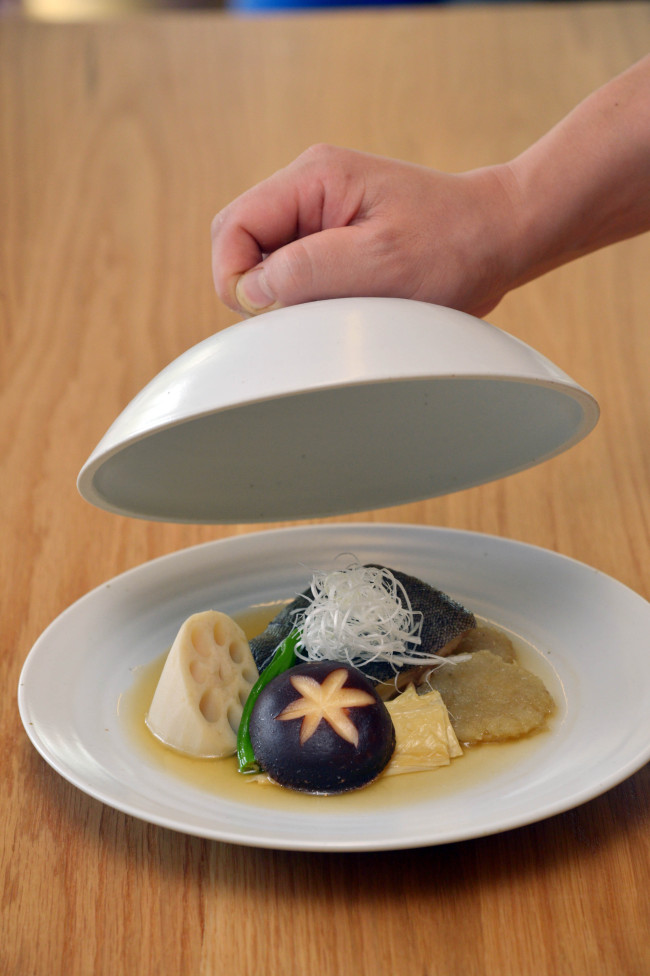Bicena stays true to hansik roots but not afraid to experiment
Modern Korean cuisine no longer has the added edge of novelty to bolster its appeal. Now that the genre is a steady fixture of the dining scene, pressure is heavy on chefs and owners to produce innovative fare that stands apart from an increasingly large crowd.
Bicena ― which opened this month in Itaewon ― understands that need and rises to the challenge.
Headed by prominent traditional Korean pottery manufacturer KwangJuYo Group, the new restaurant eschews ostentatious flamboyance for an understated, subtle approach to modern Korean cuisine.
Careful attention has been paid to the interior, which sends a respectful nod to traditional Korean art with its use of the void to create a sleek, hanbok-inspired interplay between texture and color. Deep purple and rich golden hues add pops of color to a canvas of soft, dove white.
 |
The “Pinetree Aroma in Black Cod” marries the fire of KwangJuYo’s premium Hwayo soju with the fragrance of pine needles to create an umami-rich sauce that complements the buttery fish. Potato rice cakes, crunchy lotus root and chewy bean curd skins add a fun, textural element to the dish.(Kim Myung-sub/The Korea Herald) |
The well-trained wait staff performs their duties garbed in chic uniform whose design derives from hanbok, serving up cuisine plated on KwangJuYo’s elegant dishes, cuisine that suits the overall vibe of the establishment.
“It is about how we can bring out the natural flavors of the ingredients,” Bicena chef Kim Byoung-jin, 36, explained.
Bicena’s holistic approach shines through in the restaurant’s Pinetree Aroma in Black Cod. The delectable sauce is a marriage of KwangJuYo’s premium Hwayo soju, infused with the scent of pine needles, and soy sauce. A slight hint of fermented soybean paste adds a nutty element to the umami-rich, aromatic dish.
Potato rice cakes, crunchy lotus root, chewy bean curd skins and seaweed add textural oomph to the buttery fish while inviting diners to try wrapping bits of cod in bean curd skins and seaweed for a new experience.
A la carte, the dish is slightly larger than a standard single-person portion, an intentional move on the part of Bicena owner Lucia Cho, who hopes that diners will be encouraged to order various dishes and share over drinks in tapas fashion.
What Bicena seems to be going for is that tapas attitude ― the idea of sharing, enjoying a variety of dishes, and pairing with drinks.
“I guess you could say we are a bit more experimental,” Cho, 31, said. “We went for a broad and open concept so we can evolve with our patrons.”
Cho revealed plans to review and revamp the menu as needed on a monthly basis, a move that promises to keep diners on their toes. But do not mistake Cho’s dedication to innovation as an extremist approach to hansik.
Explaining that the restaurant stays true to the foundations of Korean cuisine and to the flavors of the ingredients, Cho said, “We don’t go too far off the grid with our food.”
“Modern Korean should still be like hansik,” said Kim, elaborating how it is necessary to innovate and create within the overarching framework of traditional Korean cuisine.
Bicena
2F, 267 Itaewon-ro,
Yongsan-gu, Seoul
(02) 749-6795
Open noon to 3 p.m., 6 p.m. to 11 p.m. daily, closed every third Sunday of the month
Reservations necessary
Dishes a la carte range from 15,000 won to 54,000 won
By Jean Oh (
oh_jean@heraldcorp.com)








